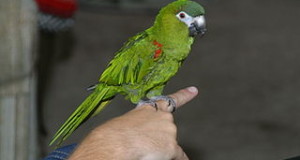 This winter’s severe weather has many bird owners re-thinking the ways in which they provide heat to their pets (and to themselves!). Late winter, spring and autumn can be even trickier than mid-winter, as warm days and frigid nights often arrive back-to-back.
This winter’s severe weather has many bird owners re-thinking the ways in which they provide heat to their pets (and to themselves!). Late winter, spring and autumn can be even trickier than mid-winter, as warm days and frigid nights often arrive back-to-back.
Note: be sure to check with an electrician before adding any heating elements to your home, and to follow the manufacture’s directions carefully. When using heat bulbs, be aware that household fixtures may not be suitable – most require the use of a ceramic fixture.
Oil-Filled Radiators
One of the best options for heating entire rooms is the oil-filled radiator. I have used these with great success in bird and reptile holding rooms in several zoos, as well as at home.
Oil-filled radiators provide even heat throughout the entire room, so that extra-hot or cool spots are eliminated. They are especially useful for those keeping several birds, as the need for individual bulbs and fixtures for each cage is eliminated. I have also relied upon oil-filled radiators when living in especially cold or drafty homes, as operating one was less expensive, and more effective, than heating the entire house.
I’ve not compared the various brands, but have found DeLonghi Oil-Filled Radiators to meet my needs admirably. I especially like the fact that their thermostats, once set, maintain temperature without further adjustment.
Incandescent Heat Bulbs
Heat-producing bulbs are generally associated with reptile care, but they are widely used in zoos to provide a warm spot for birds. While they can heat entire cages, their main value lies in their ability to provide a warm “basking site”.
As most birds are kept in open-barred cages, incandescent bulbs are perfect for providing some additional warmth without over-heating the entire enclosure (as can happen in glass aquariums housing reptiles). They are also useful for sick or newly-fledged birds. Several models provide UVA light, which has been shown to be of value to many species, as well as heat.
Red or black night-viewing bulbs, also marketed primarily for reptiles, are useful at night, or in situations where additional daytime illumination is not needed; birds do not sense the light they emit and hence will not be disturbed while sleeping.
Ceramic Heat Emitters
 Infra-red ceramic heaters, available in 40-250 watt strengths, provide warmth without light and so can be used by day and night.
Infra-red ceramic heaters, available in 40-250 watt strengths, provide warmth without light and so can be used by day and night.
In my experience, ceramic heaters spread heat over a wider area than do incandescent heat bulbs, but do not provide the room-wide coverage that is possible with oil-filled radiators.
Full Spectrum Lighting
Light is important to birds for reasons other than heat generation. More and more studies are showing that UVA and UVB radiation helps maintain strong immune systems, and encourages natural activity levels and breeding. Full spectrum bulbs designed especially for birds are now readily available; please see the article below for further information.
Further Reading
Full Spectrum Lighting for Birds
Heating and Housing Sick Birds
Crimson Sunbird image referenced from wikipedia and originally posted by Lip Kee Yap
 That Bird Blog – Bird Care and History for Pet Birds
That Bird Blog – Bird Care and History for Pet Birds




There are also Infrared Heat Panels that can be hung on a wall or attached to the cage. The panels come in 4 sizes and the heat is controlled by a themostat. Check out http://www.avitec.com.
Hello Melissa, Frank Indiviglio here.
Thanks for your interest in our blog and the most useful suggestion. I’ve not used those specific panels, but have had good results with a similar product that was mounted on the walls of several reptile exhibits. I designed.
Good luck, enjoy and please keep me posted.
Best regards, Frank Indiviglio.
Hi there. I am picking up my 4 month old baby cockatiel in a week or so and our house gets very cold. I put his cage in our closet next to the bed. We do have a apace heater but during the night my boyfriend gets too hot and turns the heater off. I was thinking of hanging some fabric in the doorway of the closet and then putting a heat lamp heat lamp above his cage… We ae on a tiht budget. Any ideas? Thanks!
Hello,
Cockateils are very cold-hearty and do fine at temperatures of 50F and even much lower if adjusted slowly. Drafts and rapid temperature changes should be avoided. A small red or black bulb (see link in article) above cage is a good idea if it has been in warmer surroundings; no need to use an “infra-red” or others made to generate a great deal of heat for reptiles; be sure cage covers, feathers etc. are not able to contact the bulb. Ceramic heaters (see link) which do not produce light, are also an inexpensive option. Best, Frank
I am elderly and have an African Grey Parrot who is 20 years old. I keep it warm for my birds and all is ok at the present time. Someone wants the bird if I get unable to care for it. They do not keep their house warm like me, it is 50 to 60 degrees in the winter. I am afraid to give her to him. What is your opinion?
Thanks, I am very worried about this. I raised a cockatiel to the age of 24 years and 8 months. I raised a starling to one month lacking 17 years old. I was very careful to keep the house warm and free of drafts.
Hello Dorothy,
Congrats on the outstanding longevity! Very nice to hear about the starling…very interesting, intelligent birds (please see here).
An oil-filled radiator might be the best option. Very inexpensive to purchase and operate, and quickly heats a room to an even temperature throughout. Safe for continuous use as far as I know (I use often at home and in zoo holding areas) but have your friend double check with an electrician beforehand. Happy, healthy holidays and many more years of enjoying your bird, Frank
Hello Frank:
I just read your post about the birds in the winter. My European Goldfinch died this morning and I’m very upset. We live in Chicago and the cold weather has been bad. I keep my condo around 70 and we do keep them warm and cover them every night. He was not a normal bird like the other one. I think he may have been the runt. My other bird, sings and is much larger. We take very good care of these birds. I clean their cages everyday, fresh water, eggs, and gourmet lettuces. I noticed last Thursday that he had no feathers under his neck and saw this yellowish skin? My husband is very familiar with these birds so he had just spoken to someone and they said don’t give them a birdbath everyday that it wasn’t good. So we thought he might have dry skin or eczema or may have started to molt. We put a little olive oil on him and he lost many tail feathers. He got very week and I even had him next to a lamp that he seemed to like the heat. Yesterday, I went to look for him and he was at the bottom of his cage and I couldn’t find him so I went to take the cage down and he bit me. He was a very playful bird and we had our little games. He was eating a lot for the past few days, seeds, he loved his eggs and I saw him drinking water. I even heard him this morning getting seeds, but heard a thump and he was lying on the floor and gone. I just don’t know what happened and wondered if birds get cancers? Could he not have survived the molting? Could he have caught a cold from us. We have had a flu/virus for a bit? What is the best way to bury them? I showed the other bird his brother and can tell he too is sad….I hope he doesn’t get sick. Any feedback would be appreciated. ~T
Hello Tracy,
Sorry to hear about your bird. They are very cold hearty…sudden changes can bother pets, perhaps, but 70 F is more than warm enough. Transmission of a pathogen from you to them is not likely.’
Unfortunately, it’s not possible to diagnose the problem via symptoms such as you describe, as varying condition show similar symptoms. they do contract cancers and a wide range of skin bacteria, fungi, etc, but that is not necessarily the cause. I think that unless you are able to arrange for a necropsy so as to possibly determine the cause of death, your best option would be to have the other bird examined by an avian vet; ask for advice re disinfecting the cage, if that is found to be needed. Please let me know if you need help in locating a vet, best, Frank